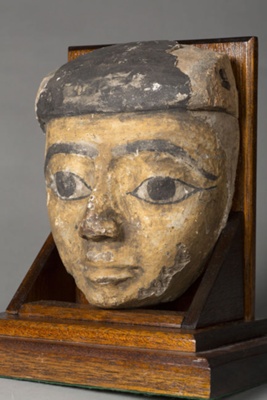< Collection search
< Collection highlights
From:UC Teece Museum of Classical Antiquities
Name/TitleSarcophagus mask
About this objectThis is the sarcophagus mask of a young man from the Ptolemaic period. Made from a wood panel, it was then covered with plaster and gesso, and painted with the face of young man. On the reverse, the pegs are still visible for attaching the mask to its sarcophagus.
Masks such as these came into fashion during the 18th Dynasty of the New Kingdom. Apart from the deceased person, the remainder of the decoration on the sarcophagus would have shown scenes relating to burial rituals and the transition to the underworld. Ideally, the deceased would be named on the sarcophagus, but there are examples where the spaces for the names of the dead are blank.
Sometimes gold paint or actual gold leaf was used to decorate faces on these masks. Gold was the colour for the faces of the gods and was also associated with the sun, the giver of life and death.
Coffins which resembled the shape of a human were used down into the Ptolemaic period, but became simpler in form over time. Wood is not a common material in Egypt, apart from Acacia, which indicates that this coffin may have been slightly more expensive.
PeriodPtolemaic
Place MadeEgypt
Place NotesSaid to be from Thebes.
Medium and MaterialsWood, plaster, gesso, paint
TechniqueCarving (processes)
TechniquePainting (image making)
MeasurementsHeight 224mm
Width 176mm
Depth 110mm
Weight 1.06kg
Subject and Association KeywordsArt and religion
Subject and Association KeywordsDeath in art
Subject and Association KeywordsFigurative art
Subject and Association KeywordsMourning customs
Subject and Association KeywordsSocial life and customs
Named CollectionThe James Logie Memorial Collection, University of Canterbury, New Zealand
Credit LineDonated by the PhiloLogie Society, 2014. From the collection of Maxwell Coulbeck.
Object TypeFunerary Objects
Object number218.14
Copyright LicenceAll rights reserved
